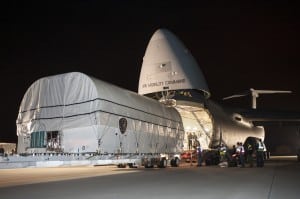Latest News
[Via Satellite 06-03-2014] The United States Air Force recently announced long-awaited decisions on its Space Fence and Family of Advanced Beyond Line of Sight Terminals (FAB-T). The $914.7 million, five-year Space Fence program award was competed for between Lockheed Martin and Raytheon. While Lockheed Martin got the Space Fence contract, Raytheon didn’t come out empty handed. The company bested Boeing in the FAB-T contract for approximately $298 million.
Space Fence
The Space Fence program was delayed by almost two years, according to a March report by the U.S. Government Accountability Office (GAO). An internal program review by the Department of Defense (DoD) and an additional delay for the strategic choices management review pushed the award date back from July 2012. As a result, the fence is not expected to reach initial operational capability until late 2018.
The contract awarded to Lockheed Martin funds the construction of a new advanced ground-based radar system on the Kwajalein Atoll, located in the Marshall Islands. The company will build two S-band phased array radars in order to increase the number of space debris tracked in the Air Force’s Space Object Catalog from tens of thousands to several hundred thousand.
The predecessor to the Space Fence, the Air Force Space Surveillance System, was shut down in October 2013 as a result of sequestration. The Air Force has modified other space situational awareness assets at its disposal to fill the void, since the Space Surveillance System was meant to continue until the Space Fence was up and running.
A second radar station is under consideration which, if approved, would likely be placed in Australia. The decision is not expected until after the Kwajalein Atoll-based site is active. In the meantime, the Joint Space Operations Center (JSpOC) at Vandenberg Air Force base in California is preparing for a massive increase in data. The JSpOC Mission System, or JMS, is slated to start operations in December 2016. JMS is under development through a separate acquisition program.
FAB-T
The FAB-T terminal program was originally a Boeing project, but delays plagued it since its beginning in 2002, prompting the Air Force to open it up to competition. The award Raytheon since received is for 84 systems to connect E4 and E6 aircraft along with ground-fixed and portable installations. The FAB-T program provides secure communications over Advanced Extremely High Frequency (AEHF) satellites for senior officials, including the president of the United States. Government budget cuts affected the FAB-T program too. The original plan included 132 more terminals for B2, B52 and B135 aircraft, which were later excluded.
Raytheon, having entered the competition in September 2012, pooled together what it had learned from other Extremely High Frequency programs, the Secure Mobile Anti-Jam Reliable Tactical Terminal (Smart-T), the Navy Multiband Terminal (NMT) and the Minuteman Minimum Essential Emergency Communications Network Program Upgrade (MMPU), to create a competitive variant in a short period of time. The company completed a system level design review in June 2013 and demonstrated a system level integrated prototype four months later.
The current contract is for Command Post Terminals (CPT) only. Raytheon said it intends to build the terminals at facilities in Marlborough, Mass. and Largo, Fla. Phase 2 production contract options are available for Low Rate Initial Production (LRIP), Full Rate Production (FRP) and Interim Contract Support (ICP) once Raytheon reaches a predetermined milestone on the current contract. The program allotted $31,274 at the time of award, with aircraft and other procurement funds planned from fiscal 2013 through 2019.
Boeing has 10 days to consider protesting the FAB-T award, as does Raytheon for the Space Fence should it see fit.
Get the latest Via Satellite news!
Subscribe Now